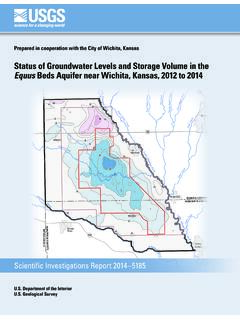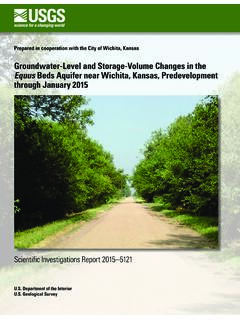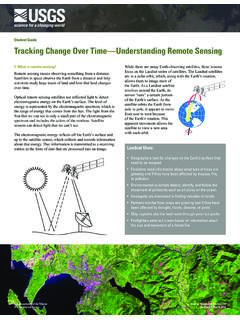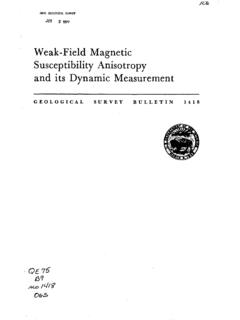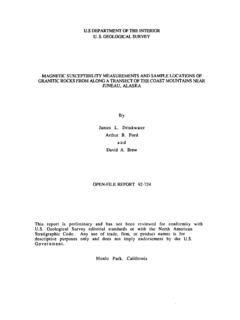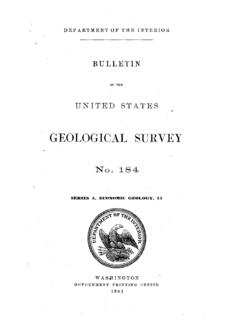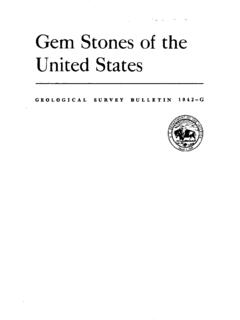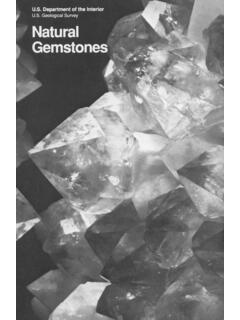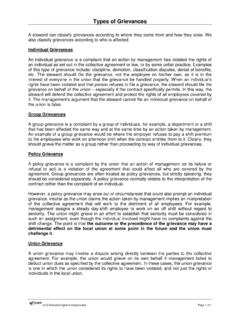Transcription of Landslide Types and Processes - USGS
1 Department of the Geological SurveyFact Sheet 2004-3072 July 2004 Landslide Types and ProcessesPrinted on recycled paperLandslides in the United States occur in all 50 States. The primary regions of Landslide occurrence and potential are the coastal and mountainous areas of California, Oregon, and Washington, the States comprising the intermountain west, and the mountainous and hilly regions of the Eastern United States. Alaska and Hawaii also experience all Types of landslides. Landslides in the United States cause approximately $ billion (year 2001 dollars) in dam-age, and kill between 25 and 50 people annually. Casualties in the United States are primar-ily caused by rockfalls, rock slides, and debris flows. Worldwide, landslides occur and cause thousands of casualties and billions in monetary losses annually.
2 The information in this publication provides an introductory primer on understanding basic scientific facts about landslides the different Types of landslides, how they are initiated, and some basic information about how they can begin to be managed as a hazard. TransversecracksMinorscarpHeadMainscarpC rowncracksCrownSurfaceofruptureMainbodyT oeofsurfaceofruptureFootSurfaceofseparat ionToeRadialcracksTransverseridgesFigure 1. An idealized slump-earth flow showing commonly used nomenclature for labeling the parts of a OF LANDSLIDESThe term Landslide describes a wide variety of Processes that result in the downward and outward movement of slope-forming materials including rock, soil, artificial fill, or a com-bination of these. The materials may move by falling, toppling, sliding, spreading, or flowing.
3 Figure 1 shows a graphic illustration of a Landslide , with the commonly accepted terminology describing its features. The various Types of landslides can be dif-ferentiated by the kinds of material involved and the mode of movement. A classification system based on these parameters is shown in figure 2. Other classification systems incor-porate additional variables, such as the rate of movement and the water, air, or ice content of the Landslide landslides are primarily associ-ated with mountainous regions, they can also occur in areas of generally low relief. In low-relief areas, landslides occur as cut-and-fill failures (roadway and building excava-tions), river bluff failures, lateral spreading landslides, collapse of mine-waste piles (especially coal), and a wide variety of slope failures associated with quarries and open-pit mines.
4 The most common Types of landslides are described as follows and are illustrated in figure 3. SLIDES: Although many Types of mass movements are included in the general term Landslide , the more restrictive use of the term refers only to mass movements, where there is a distinct zone of weakness that separates the slide material from more stable underlying material. The two major Types of slides are rotational slides and translational slide: This is a slide in which the surface of rupture is curved concavely upward and the slide movement is roughly rotational about an axis that is parallel to the ground sur-face and transverse across the slide (fig. 3A). Translational slide: In this type of slide, the Landslide mass moves along a roughly planar surface with little rotation or backward tilting (fig.)
5 3B). A block slide is a translational slide in which the moving mass consists of a single unit or a few closely related units that move downslope as a relatively coherent mass (fig. 3C).FALLS: Falls are abrupt movements of masses of geologic materials, such as rocks and boulders, that become detached from steep slopes or cliffs (fig. 3D). La Conchita, coastal area of southern Califor-nia. This Landslide and earthflow occurred in the spring of 1995. People were evacuated and the houses nearest the slide were completely destroyed. This is a typical type of Landslide . Photo by Schuster, Geological occurs along discontinuities such as fractures, joints, and bedding planes, and movement occurs by free-fall, bouncing, and rolling. Falls are strongly influenced by grav-ity, mechanical weathering, and the presence of interstitial water.
6 TOPPLES: Toppling failures are distin-guished by the forward rotation of a unit or units about some pivotal point, below or low in the unit, under the actions of gravity and forces exerted by adjacent units or by fluids in cracks (fig. 3E).FLOWS: There are five basic categories of flows that differ from one another in funda-mental Debris flow: A debris flow is a form of rapid mass movement in which a combina-tion of loose soil, rock, organic matter, air, and water mobilize as a slurry that flows downslope (fig. 3F). Debris flows include <50% fines. Debris flows are commonly caused by intense surface-water flow, due to heavy precipitation or rapid snowmelt, that erodes and mobilizes loose soil or rock on steep slopes. Debris flows also commonly mobilize from other Types of landslides that occur on steep slopes, are nearly saturated, and consist of a large proportion of silt- and sand-sized material.
7 Debris-flow source areas are often associated with steep gullies, and debris-flow deposits are usually indicated by the presence of debris fans at the mouths of gullies. Fires that denude slopes of vegetation intensify the susceptibility of slopes to debris Debris avalanche: This is a variety of very rapid to extremely rapid debris flow (fig. 3G). c. Earthflow: Earthflows have a characteristic hourglass shape (fig. 3H). The slope mate-rial liquefies and runs out, forming a bowl or depression at the head. The flow itself is elon-gate and usually occurs in fine-grained materi-als or clay-bearing rocks on moderate slopes and under saturated conditions. However, dry flows of granular material are also Mudflow: A mudflow is an earthflow con-sisting of material that is wet enough to flow rapidly and that contains at least 50 percent sand-, silt-, and clay-sized particles.
8 In some instances, for example in many newspaper reports, mudflows and debris flows are com-monly referred to as mudslides. e. Creep: Creep is the imperceptibly slow, steady, downward movement of slope-form-ing soil or rock. Movement is caused by shear stress sufficient to produce permanent deformation, but too small to produce shear failure . There are generally three Types of creep: (1) seasonal, where movement is within the depth of soil affected by seasonal changes in soil moisture and soil temperature; (2) continuous, where shear stress continu-ously exceeds the strength of the material; and (3) progressive, where slopes are reaching the point of failure as other Types of mass movements. Creep is indicated by curved tree trunks, bent fences or retaining walls, tilted poles or fences, and small soil ripples or ridges (fig.)
9 3I). LATERAL SPREADS: Lateral spreads are distinctive because they usually occur on very gentle slopes or flat terrain (fig. 3J). The dominant mode of movement is lateral extension accompanied by shear or tensile fractures. The failure is caused by liquefac-tion, the process whereby saturated, loose, cohesionless sediments (usually sands and silts) are transformed from a solid into a liquefied state. failure is usually triggered by rapid ground motion, such as that experi-enced during an earthquake, but can also be artificially induced. When coherent material, either bedrock or soil, rests on materials that liquefy, the upper units may undergo fractur-ing and extension and may then subside, translate, rotate, disintegrate, or liquefy and flow.
10 Lateral spreading in fine-grained materi-als on shallow slopes is usually progressive. The failure starts suddenly in a small area and spreads rapidly. Often the initial failure is a slump, but in some materials movement occurs for no apparent reason. Combination of two or more of the above Types is known as a complex CAUSES1. Geological causesa. Weak or sensitive materialsb. Weathered materialsc. Sheared, jointed, or fissured materialsd. Adversely oriented discontinuity (bedding, schistosity, fault, unconformity, contact, and so forth)e. Contrast in permeability and/or stiffness of materials2. Morphological causesa. Tectonic or volcanic upliftb. Glacial reboundc. Fluvial, wave, or glacial erosion of slope toe or lateral marginsd.
